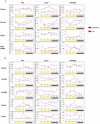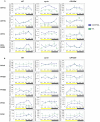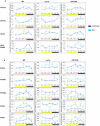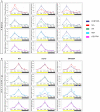Gibberellin and auxin influence the diurnal transcription pattern of photoreceptor genes via CRY1a in tomato
- PMID: 22272283
- PMCID: PMC3260215
- DOI: 10.1371/journal.pone.0030121
Gibberellin and auxin influence the diurnal transcription pattern of photoreceptor genes via CRY1a in tomato
Abstract
Background: Plant photoreceptors, phytochromes and cryptochromes, regulate many aspects of development and growth, such as seed germination, stem elongation, seedling de-etiolation, cotyledon opening, flower induction and circadian rhythms. There are several pieces of evidence of interaction between photoreceptors and phyto-hormones in all of these physiological processes, but little is known about molecular and genetic mechanisms underlying hormone-photoreceptor crosstalk.
Methodology/principal findings: In this work, we investigated the molecular effects of exogenous phyto-hormones to photoreceptor gene transcripts of tomato wt, as well as transgenic and mutant lines with altered cryptochromes, by monitoring day/night transcript oscillations. GA and auxin alter the diurnal expression level of different photoreceptor genes in tomato, especially in mutants that lack a working form of cryptochrome 1a: in those mutants the expression of some (IAA) or most (GA) photoreceptor genes is down regulated by these hormones.
Conclusions/significance: Our results highlight the presence of molecular relationships among cryptochrome 1a protein, hormones, and photoreceptors' gene expression in tomato, suggesting that manipulation of cryptochromes could represent a good strategy to understand in greater depth the role of phyto-hormones in the plant photoperceptive mechanism.
Conflict of interest statement
Figures





Similar articles
-
CRY1a influences the diurnal transcription of photoreceptor genes in tomato plants after gibberellin treatment.Plant Signal Behav. 2012 Aug;7(8):1034-6. doi: 10.4161/psb.20657. Epub 2012 Jul 25. Plant Signal Behav. 2012. PMID: 22827952 Free PMC article.
-
Diurnal and circadian rhythms in the tomato transcriptome and their modulation by cryptochrome photoreceptors.PLoS One. 2008 Jul 30;3(7):e2798. doi: 10.1371/journal.pone.0002798. PLoS One. 2008. PMID: 18665253 Free PMC article.
-
CRYPTOCHROME 1a-mediated blue light perception regulates tomato seed germination via changes in hormonal balance and endosperm-degrading hydrolase dynamics.Planta. 2023 Feb 27;257(4):67. doi: 10.1007/s00425-023-04100-8. Planta. 2023. PMID: 36843173
-
The role of auxin and gibberellin in tomato fruit set.J Exp Bot. 2009;60(5):1523-32. doi: 10.1093/jxb/erp094. Epub 2009 Mar 25. J Exp Bot. 2009. PMID: 19321650 Review.
-
Photoreceptor Mediated Plant Growth Responses: Implications for Photoreceptor Engineering toward Improved Performance in Crops.Front Plant Sci. 2017 Jul 11;8:1181. doi: 10.3389/fpls.2017.01181. eCollection 2017. Front Plant Sci. 2017. PMID: 28744290 Free PMC article. Review.
Cited by
-
Biosynthetic Pathways and Functions of Indole-3-Acetic Acid in Microorganisms.Microorganisms. 2023 Aug 12;11(8):2077. doi: 10.3390/microorganisms11082077. Microorganisms. 2023. PMID: 37630637 Free PMC article. Review.
-
CRY1a influences the diurnal transcription of photoreceptor genes in tomato plants after gibberellin treatment.Plant Signal Behav. 2012 Aug;7(8):1034-6. doi: 10.4161/psb.20657. Epub 2012 Jul 25. Plant Signal Behav. 2012. PMID: 22827952 Free PMC article.
-
Pivotal Roles of Cryptochromes 1a and 2 in Tomato Development and Physiology.Plant Physiol. 2019 Feb;179(2):732-748. doi: 10.1104/pp.18.00793. Epub 2018 Dec 12. Plant Physiol. 2019. PMID: 30541876 Free PMC article.
-
Genomic Insights and Functional Analysis Reveal Plant Growth Promotion Traits of Paenibacillus mucilaginosus G78.Genes (Basel). 2023 Feb 2;14(2):392. doi: 10.3390/genes14020392. Genes (Basel). 2023. PMID: 36833318 Free PMC article.
-
Cryptochrome 2 extensively regulates transcription of the chloroplast genome in tomato.FEBS Open Bio. 2017 Mar 1;7(4):456-471. doi: 10.1002/2211-5463.12082. eCollection 2017 Apr. FEBS Open Bio. 2017. PMID: 28396831 Free PMC article.
References
-
- Sakai T, Nagashima A, Uehara Y. The ABC subfamily B auxin transporter AtABCB19 is involved in the inhibitory effects of N-1-Naphthyphthalamic acid on the phototropic and gravitropic responses of Arabidopsis hypocotyls. Plant and Cell Physiology. 2008;49:1250–1255. - PubMed
Publication types
MeSH terms
Substances
LinkOut - more resources
Full Text Sources

